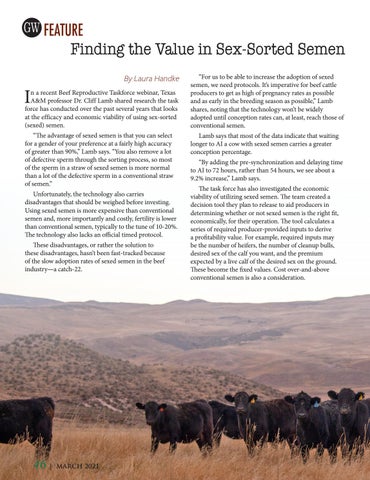GW FEATURE
Finding the Value in Sex-Sorted Semen By Laura Handke
I
n a recent Beef Reproductive Taskforce webinar, Texas A&M professor Dr. Cliff Lamb shared research the task force has conducted over the past several years that looks at the efficacy and economic viability of using sex-sorted (sexed) semen. “The advantage of sexed semen is that you can select for a gender of your preference at a fairly high accuracy of greater than 90%,” Lamb says. “You also remove a lot of defective sperm through the sorting process, so most of the sperm in a straw of sexed semen is more normal than a lot of the defective sperm in a conventional straw of semen.” Unfortunately, the technology also carries disadvantages that should be weighed before investing. Using sexed semen is more expensive than conventional semen and, more importantly and costly, fertility is lower than conventional semen, typically to the tune of 10-20%. The technology also lacks an official timed protocol. These disadvantages, or rather the solution to these disadvantages, hasn’t been fast-tracked because of the slow adoption rates of sexed semen in the beef industry—a catch-22.
46 || MARCH MARCH 2021 2021
“For us to be able to increase the adoption of sexed semen, we need protocols. It’s imperative for beef cattle producers to get as high of pregnancy rates as possible and as early in the breeding season as possible,” Lamb shares, noting that the technology won’t be widely adopted until conception rates can, at least, reach those of conventional semen. Lamb says that most of the data indicate that waiting longer to AI a cow with sexed semen carries a greater conception percentage. “By adding the pre-synchronization and delaying time to AI to 72 hours, rather than 54 hours, we see about a 9.2% increase,” Lamb says. The task force has also investigated the economic viability of utilizing sexed semen. The team created a decision tool they plan to release to aid producers in determining whether or not sexed semen is the right fit, economically, for their operation. The tool calculates a series of required producer-provided inputs to derive a profitability value. For example, required inputs may be the number of heifers, the number of cleanup bulls, desired sex of the calf you want, and the premium expected by a live calf of the desired sex on the ground. These become the fixed values. Cost over-and-above conventional semen is also a consideration.
